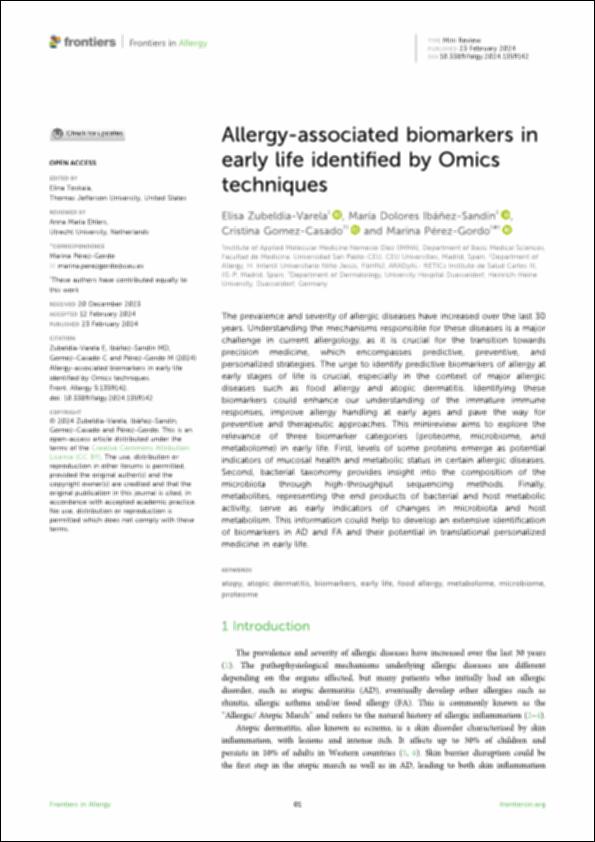Please use this identifier to cite or link to this item:
http://hdl.handle.net/10637/15752Allergy-associated biomarkers in early life identified by Omics techniques
| Title: | Allergy-associated biomarkers in early life identified by Omics techniques |
| Authors : | Zubeldia Varela, Elisa Ibáñez Sandín, María Dolores Gómez Casado, Cristina Pérez Gordo, Marina |
| Keywords: | Atopy; Atopic dermatitis; Biomarkers; Early life; Food allergy; Metabolome; Microbiome; Proteome |
| Publisher: | Frontiers Media |
| Citation: | Zubeldia-Varela E, Ibáñez-Sandín MD, Gomez-Casado C and Pérez-Gordo M (2024) Allergy-associated biomarkers in early life identified by Omics techniques. Front. Allergy 5:1359142. doi: 10.3389/falgy.2024.1359142 |
| Abstract: | The prevalence and severity of allergic diseases have increased over the last 30 years. Understanding the mechanisms responsible for these diseases is a major challenge in current allergology, as it is crucial for the transition towards precision medicine, which encompasses predictive, preventive, and personalized strategies. The urge to identify predictive biomarkers of allergy at early stages of life is crucial, especially in the context of major allergic diseases such as food allergy and atopic dermatitis. Identifying these biomarkers could enhance our understanding of the immature immune responses, improve allergy handling at early ages and pave the way for preventive and therapeutic approaches. This minireview aims to explore the relevance of three biomarker categories (proteome, microbiome, and metabolome) in early life. First, levels of some proteins emerge as potential indicators of mucosal health and metabolic status in certain allergic diseases. Second, bacterial taxonomy provides insight into the composition of the microbiota through high-throughput sequencing methods. Finally, metabolites, representing the end products of bacterial and host metabolic activity, serve as early indicators of changes in microbiota and host metabolism. This information could help to develop an extensive identification of biomarkers in AD and FA and their potential in translational personalized medicine in early life. |
| URI: | http://hdl.handle.net/10637/15752 |
| Rights : | http://creativecommons.org/licenses/by-nc-nd/4.0/deed.es Open Access |
| ISSN: | 2673-6101 |
| Issue Date: | 23-Feb-2024 |
| Center : | Universidad San Pablo-CEU |
| Appears in Collections: | Medicina |
Items in DSpace are protected by copyright, with all rights reserved, unless otherwise indicated.


